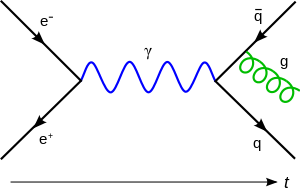MHV amplitudes
In theoretical particle physics, maximally helicity violating amplitudes (MHV) are amplitudes with n massless external gauge bosons, where n–2 gauge bosons have a particular helicity and the other two have the opposite helicity. These amplitudes are called MHV amplitudes, because at tree level, they violate helicity conservation to the maximum extent possible. The tree amplitudes in which all gauge bosons have the same helicity or all but one have the same helicity vanish.
| Quantum field theory |
|---|
 |
| History |
|
Background
|
|
|
Scientists
|
MHV amplitudes may be calculated very efficiently by means of the Parke–Taylor formula.
Although developed for pure gluon scattering, extensions exist for massive particles, scalars (the Higgs) and for fermions (quarks and their interactions in QCD).
Parke–Taylor amplitudes
Work done in 1980s by Stephen Parke and Tomasz Taylor[1] found that when considering the scattering of many gluons, certain classes of amplitude vanish at tree level; in particular when fewer than two gluons have negative helicity (and all the rest have positive helicity):
The first non-vanishing case occurs when two gluons have negative helicity. Such amplitudes are known as "maximally helicity violating" and have an extremely simple form in terms of momentum bilinears, independent of the number of gluons present:
The compactness of these amplitudes makes them extremely attractive, particularly with the impending start-up of the LHC, for which it will be necessary to remove the dominant background of standard model events. A rigorous derivation of the Parke–Taylor amplitudes was given by Berends and Giele.[2]
CSW rules
The MHV were given a geometrical interpretation using Witten's twistor string theory[3] which in turn inspired a technique of "sewing" MHV amplitudes together (with some off-shell continuation) to build arbitrarily complex tree diagrams. The rules for this formalism are called the CSW rules (after Freddy Cachazo, Peter Svrcek, Edward Witten).[4]
The CSW rules can be generalised to the quantum level by forming loop diagrams out of MHV vertices.[5]
There are missing pieces in this framework, most importantly the vertex, which is clearly non-MHV in form. In pure Yang-Mills theory this vertex vanishes on-shell, but it is necessary to construct the amplitude at one loop. This amplitude vanishes in any supersymmetric theory, but does not in the non-supersymmetric case.
The other drawback is the reliance on cut-constructibility to compute the loop integrals. This therefore cannot recover the rational parts of amplitudes (i.e. those not containing cuts).
The MHV Lagrangian
A Lagrangian whose perturbation theory gives rise to the CSW rules can be obtained by performing a canonical change of variables on the light-cone Yang-Mills (LCYM) Lagrangian.[6] The LCYM Lagrangrian has the following helicity structure:
The transformation involves absorbing the non-MHV three-point vertex into the kinetic term in a new field variable:
When this transformation is solved as a series expansion in the new field variable, it gives rise to an effective Lagrangian with an infinite series of MHV terms:[7]
The perturbation theory of this Lagrangian has been shown (up to the five-point vertex) to recover the CSW rules. Moreover, the missing amplitudes which plague the CSW approach turn out to be recovered within the MHV Lagrangian framework via evasions of the S-matrix equivalence theorem. [8]
An alternative approach to the MHV Lagrangian recovers the missing pieces mentioned above by using Lorentz-violating counterterms.[9]
BCFW recursion
BCFW recursion, also known as the Britto–Cachazo–Feng–Witten (BCFW) on-shell recursion method, is a way of calculating scattering amplitudes.[10] Extensive use is now made of these techniques.[11]
References
- Parke, Stephen J.; Taylor, T. R. (1986-06-09). "Amplitude for n-Gluon Scattering". Physical Review Letters. American Physical Society (APS). 56 (23): 2459–2460. doi:10.1103/physrevlett.56.2459. ISSN 0031-9007.
- Berends, F.A.; Giele, W.T. (1988). "Recursive calculations for processes with n gluons". Nuclear Physics B. Elsevier BV. 306 (4): 759–808. doi:10.1016/0550-3213(88)90442-7. ISSN 0550-3213.
- Witten, Edward (2004-10-07). "Perturbative Gauge Theory as a String Theory in Twistor Space". Communications in Mathematical Physics. Springer Science and Business Media LLC. 252 (1–3): 189–258. arXiv:hep-th/0312171. doi:10.1007/s00220-004-1187-3. ISSN 0010-3616.
- Cachazo, Freddy; Svrcek, Peter; Witten, Edward (2004-09-03). "MHV Vertices And Tree Amplitudes In Gauge Theory". Journal of High Energy Physics. Springer Science and Business Media LLC. 2004 (09): 006–006. arXiv:hep-th/0403047. doi:10.1088/1126-6708/2004/09/006. ISSN 1029-8479.
- Brandhuber, A.; Travaglini, G. (2007). Quantum MHV Diagrams. World Scientific. p. 443-456. arXiv:hep-th/0609011. doi:10.1142/9789812708267_0054. ISBN 978-981-270-552-5.
- Mansfield, Paul (2006-03-09). "The lagrangian origin of MHV rules". Journal of High Energy Physics. Springer Science and Business Media LLC. 2006 (03): 037–037. arXiv:hep-th/0511264. doi:10.1088/1126-6708/2006/03/037. ISSN 1029-8479.
- Ettle, James H; Morris, Tim R (2006-08-01). "Structure of the MHV-rules lagrangian". Journal of High Energy Physics. Springer Science and Business Media LLC. 2006 (08): 003–003. arXiv:hep-th/0605121. doi:10.1088/1126-6708/2006/08/003. ISSN 1029-8479.
- Ettle, James H; Fu, Chih-Hao; Fudger, Jonathan P; Mansfield, Paul R.W; Morris, Tim R (2007-05-08). "S-matrix equivalence theorem evasion and dimensional regularisation with the canonical MHV lagrangian". Journal of High Energy Physics. Springer Science and Business Media LLC. 2007 (05): 011–011. arXiv:hep-th/0703286. doi:10.1088/1126-6708/2007/05/011. ISSN 1029-8479.
- Brandhuber, Andreas; Spence, Bill; Travaglini, Gabriele; Zoubos, Konstantinos (2007-07-02). "One-loop MHV rules and pure Yang-Mills". Journal of High Energy Physics. Springer Science and Business Media LLC. 2007 (07): 002–002. arXiv:0704.0245. doi:10.1088/1126-6708/2007/07/002. ISSN 1029-8479.
- Britto, Ruth; Cachazo, Freddy; Feng, Bo; Witten, Edward (2005-05-10). "Direct Proof of the Tree-Level Scattering Amplitude Recursion Relation in Yang-Mills Theory". Physical Review Letters. American Physical Society (APS). 94 (18): 181602. arXiv:hep-th/0501052. doi:10.1103/physrevlett.94.181602. ISSN 0031-9007.
- Feng, Bo; Luo, Mingxing (2012). "An introduction to on-shell recursion relations". Frontiers of Physics. Springer Science and Business Media LLC. 7 (5): 533–575. arXiv:1111.5759. doi:10.1007/s11467-012-0270-z. ISSN 2095-0462.